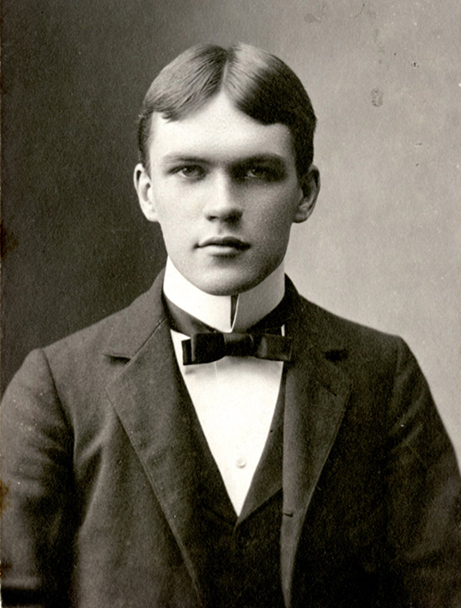
Special Collections and Archives, VCU Libraries
James Branch Cabell was born at his grandmother’s home in Richmond, Va., on April 14, 1879 — two years after the last federal troops withdrew from the South and Reconstruction ended. He lived 79 years, passing away on May 5, 1958 — four years after the Supreme Court decision Brown v. Board of Education ruled that racial segregation in public schools was unconstitutional.
To understand this writer’s life and historical context, consider that Cabell’s life spanned the economic depression and Panic of 1893, the disillusionment of the Great War, the establishment of woman suffrage, the Roaring ’20s, the moral sternness of Prohibition (and its repeal), the Great Depression, the rise of global totalitarianism and World War II and the beginnings of racial equality and the civil rights movement. Cabell was schooled in Lost Cause mythology and Victorian social expectations, but was deeply attached to family and friends who were considered liberal reformers: Beverley Bland Munford and Mary-Cooke Branch Munford, Walter Russell Bowie and Ellen Glasgow among them.
After Reconstruction, the city of Richmond underwent tremendous changes, as industrialization increased the city’s economic diversity. Along with the tobacco business, Richmond became home to metal works, food processing, lumber and wood manufacturing, railroads, publishing, banking and insurance businesses. The telephone was introduced in 1879. The first motor vehicle arrived in 1900. Public health and public education, both of which had long been substandard, became the focus of Progressive Era reformers and a new School of Social Economy — the first in the South — opened to train social workers. The Woman’s Club movement thrived. The Equal Suffrage League was formed. Richmond hosted conventions and welcomed visitors, and even as it honored the past, Richmond looked to the future.
Early years
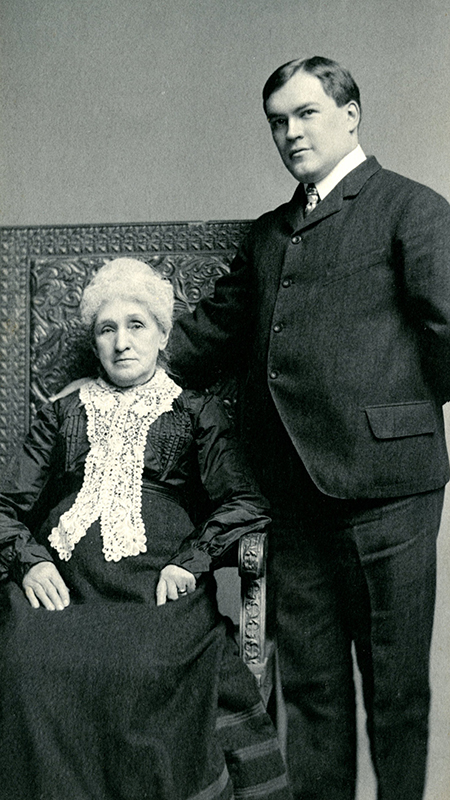
Special Collections and Archives, VCU Libraries
James Branch Cabell was born into the illustrious and influential Cabell and Branch families of Virginia. His father, Robert Gamble Cabell, Jr., was a physician. His mother, Anne Harris, was the beautiful, headstrong daughter of Col. James Read and Martha Louise Patteson Branch. The Cabells had three sons, James, Robert and John, but the marriage was not a happy one. Cabell’s parents separated, then divorced in 1907. He does not seem to have had a warmly affectionate relationship with either parent.
Cabell was shy and bookish. At the age of 14, he went to William and Mary College, where he studied classics, French and English literature. He studied works of courtly love and wrote poetry. He taught classes in French and Greek while an undergraduate. He left William and Mary in 1898, then lived for two years in New York City working for the New York Herald. In 1900 he returned to Richmond and worked for the Richmond News where he often reported on the happenings in police court.
After the daily grind of newspaper writing, Cabell turned to magazines. Many of these short stories would be reworked and later appear in Cabell’s books. Cabell’s first book, The Eagle’s Shadow, was published in 1904. He dedicated it to his grandmother, Martha Louise Patteson Branch.
Marriage
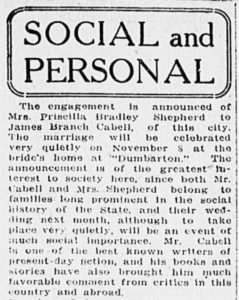
Oct. 24, 1913, p. 5
In 1913, at 33, Cabell (who by this time had published eight books) married Rebecca Priscilla Bradley Shepherd (nicknamed “Percie”). Shepherd had been widowed for two years and had inherited a significant estate from her late husband. She was four years older than Cabell and had five children from her first marriage. She was fond of motor cars and enjoyed driving.
The Richmond Times-Dispatch declared their engagement “of the greatest interest to society here, since both Mr. Cabell and Mrs. Shepherd belong to families long prominent in the social history of the State.” The wedding took place in November at the bride’s home, Dumbarton Grange. Cabell moved to Dumbarton Grange where the couple lived for many years. Their son, Ballard Hartwell Cabell was born in 1915 with Down syndrome, a genetic condition that was little understood at the time. Cabell dearly loved Ballard, whom he always described as “exceptional” (MacDonald, pp. 204-205).
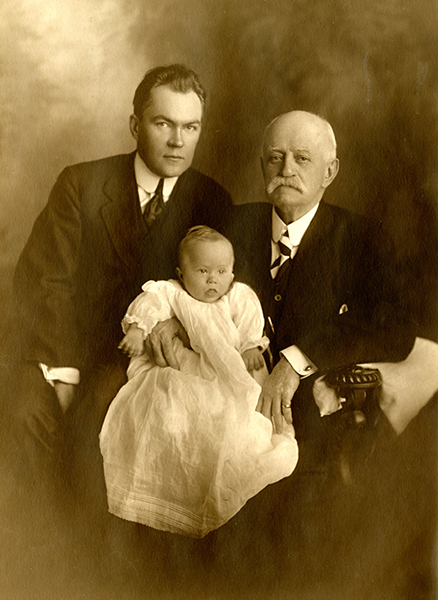
Special Collections and Archives, VCU Libraries
Jurgen and what came after
Cabell’s writing career was progressing, but his growing reputation became notoriety when Jurgen: A Comedy of Justice attracted the attention of John Sumner and the New York Society for the Suppression of Vice. The printing plates were seized on January 14, 1920, beginning a two-year prosecution on charges of obscenity. Cabell and his publisher, Robert M. McBride eventually won the case, and the national attention brought Cabell fame and sold many copies of Jurgen.
Throughout the 1920s, Cabell continued to publish in the style of Jurgen (pronounced Jer-gen), a combination of satire, symbolism and fantasy, set in a mythical medieval French province, called Poictesme (Pwa-tem). The name was a compound of two provinces located in the south of France, Poitiers and Angouleme. In these books, Cabell blended an assortment of myths and legends laced with puns, anagrams and allegories. Eventually, Cabell would rework his entire corpus into an 18-volume series titled The Biography of the Life of Manuel. Cabell claimed that he considered the originally 25 separate works to be a single story about the character Dom Manuel and his descendants through many generations. Cabell supervised publication of a uniform edition known as the The Works of James Branch Cabell , which is presented on the title pages as the Storisende Edition (1927-1930).
Friends and professional associates
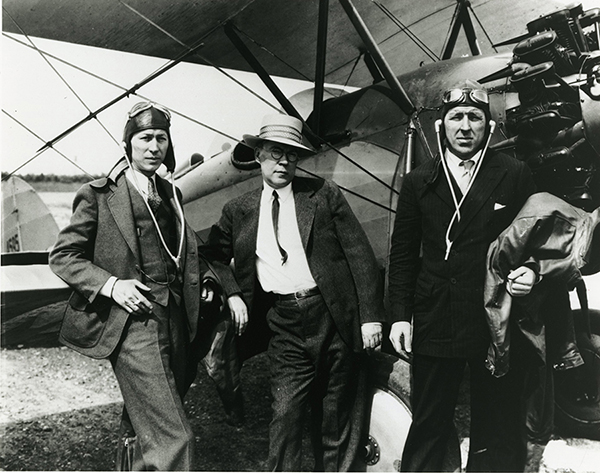
Special Collections and Archives, VCU Libraries
James Branch Cabell maintained a great many friends and correspondents among the writers, literary critics and artists of his day, including Ellen Glasgow, H. L. Mencken, Sinclair Lewis, Burton Rascoe, Joseph Hergesheimer, Marjorie Kinnan Rawlings, Louis Untermeyer, Carl Van Vechten and Ted Shawn.
In 1918, Cabell, Mr. and Mrs. Samuel Travers Clover, Dr. Orie Latham Hatcher and several other writers formed the Virginia Writer’s Club. Three years later, Cabell lent his talents to The Reviewer, a southern literary magazine started by Emily Tapscott Clark, Hunter Stagg, Mary Dallas Street and Margaret Freeman, who would one day become Cabell’s second wife. He also served as editor of the Virginia War History Commission (1919-1926) and later joined Theodore Dreiser, Eugene O’Neil and others on the editorial board of the American Spectator (1932-1935). In 1937, Cabell was elected to the American Academy of Arts and Letters.
Later years
Priscilla Bradley Cabell died on March 29, 1949. Ballard suggested to his father that he marry Margaret Waller Freeman, and Cabell’s friend Marjorie Rawlings concurred. The marriage was arranged and took place June 15, 1950. It was not a union based on love, though perhaps affection, and Margaret was loyal to both James and Ballard. She was active in advancing the literary legacy of her husband, co-editing a volume of Cabell’s letters titled Between Friends: Letters of James Branch and Others. Margaret founded a group to safeguard Cabell’s legacy, and throughout the 1960s and 1970s she encouraged scholars and academics to write about her husband.
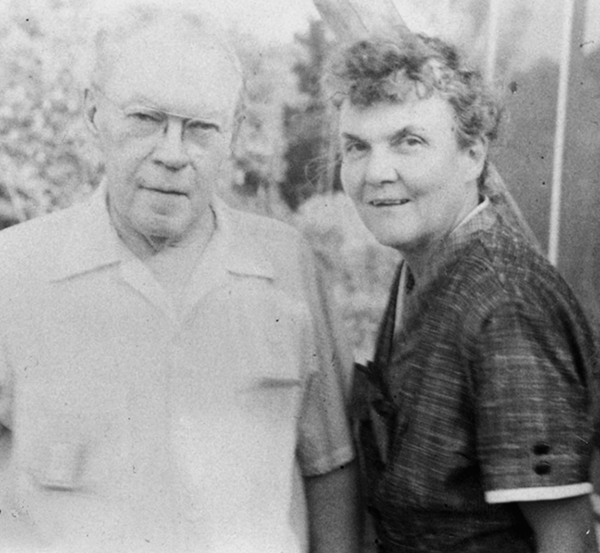
Special Collections and Archives, VCU Libraries
Cabell’s final work, As I Remember It: Some Epilogues in Recollections, a memoir, had two dedicatory acrostics: the first poem addressed to “Percie,” Priscilla, his wife of thirty-five years; the second to Margaret, his second wife and “collaborator.” Its epigraph was taken from Tennyson’s poem “Ulysses.”
Though his health declined, James Branch Cabell outlived many of his friends. On his 79th birthday the author replied to Carl Van Vechten’s greetings, “It is a matter in which I both need and like sympathy….With Rascoe’s death, you have become virtually the only author whom I know—or rather, used to know, inasmuch as we never see each other nowadays, nor seem likely ever to meet again upon this side of the Styx.”
Cabell died of a cerebral hemorrhage on May 5, 1958 at his home in Richmond, and was buried in the graveyard of the Emmanuel Church at Brook Hill next to Percie and her first husband Emmett Shepherd. The following year, the remains of Cabell and his first wife were reinterred in Hollywood Cemetery. Ballard, a painter, lived until 1980. Margaret died in 1983 at the age of 90 having seen to the naming of James Branch Cabell Library, the creation of the Cabell Room and the establishment of the James Branch Cabell Library Associates.